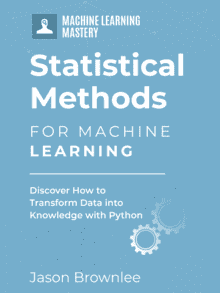You do not need to know statistics before you can start learning and applying machine learning. You can start today.
Nevertheless, knowing some statistics can be very helpful to understand the language used in machine learning. Knowing some statistics will eventually be required when you want to start making strong claims about your results.
In this post you will discover a few key concepts from statistics that will give you the confidence you need to get started and make progress in machine learning.
Kick-start your project with my new book Statistics for Machine Learning, including step-by-step tutorials and the Python source code files for all examples.
Let’s get started.

Crash Course in Statistics for Machine Learning
Photo by Rob Ireton, some rights reserved.
Statistical Inference
There are processes in the real world that we would like to understand.
For example human behaviours like clicking on an add or buy a product.
They are not straightforward to understand. There are complexities and uncertainties. The process has an element of randomness to it (it is stochastic).
We understand these processes by making observation and collecting data. The data is not the process, it is a proxy for the process that gives us something to work with to understand the process.
The methods we use to make observations and collect or sample data also introduce uncertainties into the data. Together with the inherent randomness in the real-world process, we now have two sources of randomness in our data.
Given the data we have collected, we clean it up, create a model and try to say something about the process in the real world.
For example, we may make a prediction or describe the relationships between elements within the process.
This is called statistical inference. We go from a real world stochastic process, collect and model the process in data, and come back to the process in the world and say something about it.
Need help with Statistics for Machine Learning?
Take my free 7-day email crash course now (with sample code).
Click to sign-up and also get a free PDF Ebook version of the course.
Statistical Population
Data belongs to a population (N). A data population is all possible observations that could be made. The population is abstract, an ideal.
When you make observations or work with data, you are working with a sample of the population (n).
If you are working on a prediction problem, you are seeking to best leverage n to characterize N so that you minimize the errors in the predictions you make from other n your system will encounter.
You must be careful in your selection and handling of your sample. The size and qualities of the data will affect your ability to effectively characterize the problem, to make predictions or describe the data. The randomness (biases) introduced during the collection of must be considered and even manipulated, managed or corrected.
Big Data
The promise of big data is that you no longer need to worry about sampling data, that you can work with all the data.
That you are working with N and not n. This is false and dangerous thinking.
You are still working with a sample. You can see how this is the case. For example if you are modeling customer data in a SaaS business, you are working with a sample of the population that found and signed up for the service prior to your modeling. Those caveats bias the data you are working with.
You must be careful to not over generalize your findings, to be cautious about claims beyond that data you have observed. For example, the trends of all users of twitter do not represent the trends of all humans.
In the other direction, big data allows you model each individual entities, such as one customer (n=1), using all data collected on that entity to date. This is a powerful, exciting, and computationally demanding frontier.
Statistical Models
The world is complicated and we need to simplify it with assumptions in order to understand it.
A model is a simplification of a process in the real world. It will always be wrong, but it might be useful.
A statistical model describes the relationship between data attributes, such as a dependent variable with independent variables.
You can think about your data before hand and propose a model that describes relationships between the data.
You can also run machine learning algorithms that assume a type of model of a specific form will describe the relationship and find the parameters to fit the model to the data. This is where notions of a fit, overfitting and underfitting come from, where the model is too specific or not specific enough in its ability to generalize beyond observed data.
Simpler models are easier to understand and use than more complex models. As such, it is a good idea to start with the simplest models for a problem and increase complexity as you need. For example assume a linear form for your model before considering a non-linear, or a parametric before a non-parametric model.
Summary
In this post you took a brief crash course in key concepts in statistics that you need when getting started in machine learning.
Specifically, the ideas of statistical inference, statistical populations, how ideas from big data fit in, and statistical models.
Take it slow, statistics is a big field and you do not need to know it all.
Don’t rush out and purchase an undergraduate textbook on statistics, at least, not yet. It is too much, too soon.
If you are looking for more information, I would recommend that you start out by reading the introductory sections on statistics in machine learning books, for example: chapter 2 of Doing Data Science: Straight Talk from the Frontline, from which this post was inspired.
For more information, consider taking a look at some of the linked Wikipedia articles.
Going further again, Khan Academy has some great modules on statistics and probability.








welcome to advanced analytics and big data
many people don´t think about it and I wonder why even literate statisticians do this – using samples instead of full data sets
such an approach will spoil predictions because the model is being disturbed or even useless introducing more arbitrary and random assumptions by samples
even worse, statistics tries to compensate with various confidence, relevance and probability factors but again a sample is not the real world
think about identifying e.g. rare patterns, you´ll simply get screwed because you omit information when using samples – misguiding your decision
so, the best way is to do the math on all of your data not just on samples
Very nice, approachable — I especially like that you characterized some of the common fallacies of “big data” and alluded to sample/design issues without overwhelming the uninitiated. I don’t know if those that are not already familiar with the issues at a deeper level will still get it — but cheers to you for doing a really good job trying to elucidate these sorts of issues, and pointing people to where they could learn more.
Thanks Jennifer